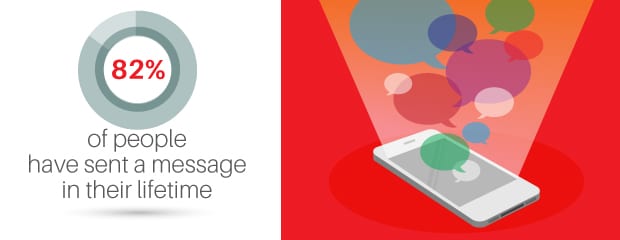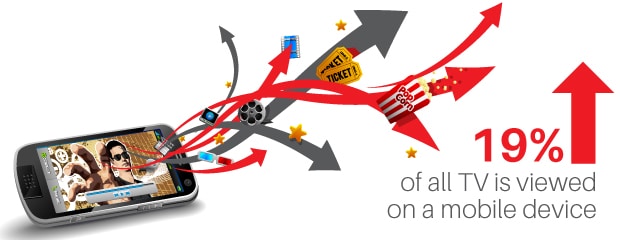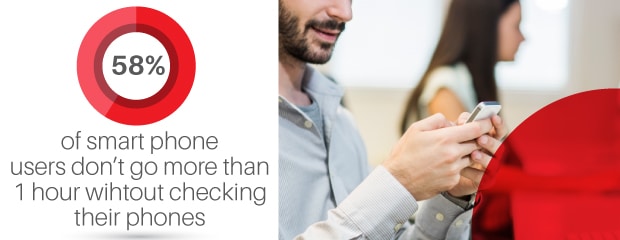If you’re old enough to remember when people would hold up lighters at a rock show, you’re probably still amazed when, instead, 30 thousand people hold up their cell phones. For such a young technology, cell phones have become amazingly common, penetrating almost every strata and class of the entirety of the human population. According to the United Nations, there are nearly 6.8 billion cell phone subscriptions currently.

Given there are only seven billion people in the world, that number represents an amazing density of adoption for a technology that, just fifty years ago, was science fiction. Indeed, the origin of the cell phone is often traced, at least anecdotally, to the 1966 television show Star Trek. In the show, Captain Kirk would often flip open a simple communications device and speak to the Enterprise in orbit.
In Search of a Portable Communications Device
Star Trek’s idea of a mobile communications device — portable technology that wasn’t wired into the wall — was inspirational to engineers at Motorola, who then developed the first true cellular phone. Made available to the public in the year 1983, the Motorola Dynatac allowed a user to make a phone call outside a vehicle.
Less than twenty years after Star Trek, the first cellular phone was made available to the public. In the thirty-year history of cell phones that would follow, cell phones would go through several drastic changes, sometimes driven by a leap in technology and sometimes driven by a paradigm shift in how users interacted with technology. Since the introduction of the DynaTAC, cell phones have moved through four basic generations, leading to the devices we rely on today and to the fifth generation that is yet to come.
First Generation: 1973 – A Heavy Start
While Motorola often takes well-deserved credit for having introduced the first cell phone, the phone was itself difficult to use. Yes, it was portable, but it was also bulky and heavy. The prototype was built in 1973, but that device offered little more than 30 minutes of talk time and took over 10 hours to fully charge. However, it was still a leap in technology, and investment by Motorola lead to refinement of the concept.
The distinguishing characteristic of First Generation (or 1G) networks is perhaps that the network itself was analog. Developed by Bell Labs, the Advanced Mobile Phone System made its debut in America in 1983, allowing the phone that it supported to finally be sold. This helps explain the 10-year gap between the Motorola prototype and the commercially available DynaTAC.
These analog phones basically sent out a signal on a frequency — but each user used a separate “channel” in the same frequency, requiring both significant computing power on the back end and significant bandwidth. This made it incredibly easy to eavesdrop or even clone these early phones.
The successor to the Motorola DynaTAC, the Motorola MicroTAC, was introduced in 1989. The first true “flip” phone, the MicroTAC was still heavy but featured a case that would flip open to resemble a more traditional phone shape.
First Generation at a Glance:
- General Weight: 1.5 lbs.
- General Size: Roughly the size of a brick
- Talk time: Between 30 – 90 minutes
- Charge Time: 5 – 10 hours
- Display: LED
- Speed: 2.4 KBPS
Second Generation: 1993 – Flipping Out

Second generation cell phones made a big leap: They went digital. Analog networks had several severe drawbacks, but among the most limiting was the large amount of bandwidth — and data — every call used. A digital network allowed data to be sent much more efficiently and much more quickly. The switch to digital also allowed phones to become much smaller and much easier to use.
The Motorola SmarTAC is among those digitally-enabled smaller phones. With a classic “clamshell” shape, this phone had a talk time of roughly four hours and was less than a third of the weight of the earlier Motorola MicroTAC. The SmarTAC stands out as a truly mobile cellular phone, as this device could easily fit and be carried comfortably in a coat pocket or a purse.
The Firsts of Second Generation Phones:
- First in-phone camera
- First in-phone address book
- First flip-open phone
- First service plans
The year 1998 marked the beginning of the cell phone boom, with carriers, service providers and phone manufacturers settling into a set of mutually beneficial business models. This model allowed people to purchase a phone at a heavily discounted price as long as they agreed to a long-term service plan usually around two or three years. This business model is still largely used today.
By making cellular phones available to groups beyond the extremely rich, carriers and manufacturers were able to turn these devices into common amenities. And no cell phone of the second generation — or even subsequent generations — was more common than the Nokia 3210, which debuted in 1999. This is the phone that many people still think of when they imagine a “cell phone” and not a “smartphone.”
The Nokia 3210 may not have introduced many of second-generation perks we now take for granted, but it did use them to great effect. For example, customers could play games and send photos with the Nokia 3210. They could also send text messages — while there was no designated keyboard, users could get to the letter they wanted by successively striking the number keys. For example, if you wanted to write a “C,” you would hit the 1 button three times.
Obviously, this was a cumbersome, time-consuming way to communicate, but it did introduce several “text phrases” to the world. This way of communicating also introduced the swapping of numbers in for letters, as numbers were significantly easier to type. Even still, 82% of all people have sent at least one text message over the course of his or her life — and, of course, many people have sent many more.
Second Generation at a Glance:
- General Weight: .5 lbs.
- General Size: About the size of a large candy bar
- Talk time: Four hours
- Charge Time: Four hours
- Display: Backlit monochrome
- Speed: 64KPBS
Third Generation: 2002 – Enter the Smart Phone
If the second generation offered a huge leap over the first, the third generation also represents a huge leap over the second. From the beginning of the twenty-first century, cell phones have been quickly transforming from simple voice-communication devices to pocket-sized computers. The introduction of the “smart phone” had a huge impact on the field of cellular phones.
The smart phone can be defined as a mobile device that, in addition to making phone calls, incorporates many functions you would typically see in a personal computer. For example, while GPS was first introduced in second-generation mobile phones, it was executed much more broadly in third generation devices. The same goes for Internet browsing and downloading and playing music.
Firsts of Third Generation Devices:
- First high-quality in-phone camera (a major selling point)
- First internet browser in phone
- First Blackberry with built-in phone
As Internet speeds in the home sped up thanks to wide broadband adoption, many consumers expected their mobile devices to exhibit similar downloading and running speeds. This put pressure on manufacturers to innovate new, faster ways for phones to function without losing the intuitive operations that made cell phones easy to use.
Perhaps no company blended these two demands — and marketed their ability to do so — better than Apple. The introduction of Apple’s iPhone changed the field of mobile devices dramatically, just as it changed the course of Apple as a company. The iPhone’s reliance on “apps” meant that phones could be tailored to perform multiple tasks. In this way, the device could adapt to each user, and programmers continually developed ways to enhance this capability in modern mobile devices.
Third Generation at a Glance:
- General Weight: .29 lbs.
- General Size: Index card-sized
- Talk time: Eight Hours
- Charge Time: Four hours
- Display: 18-bit glossy display
- Speed: 2000KBPS
The Fourth Generation: 2010 – Big Data

The Motorola RAZR was one of the biggest phones of the third generation: sleekly designed, slim and light, it was a huge hit and helped to change the way people think about their phones. But by the time the fourth generation of phones rolled in around 2010, the RAZR was completely and utterly obsolete. Why? Cell phone data evolved.
As more and more users depended on their mobile devices to perform like computers, manufacturers were under increased pressure to find solutions to the biggest bottleneck: the speed of data. With advances in wireless technology and the small processors in phones, manufacturers were finally able to let users experience the Internet at incredibly high speeds over a cellular wireless network.
Fourth Generation Firsts
- Broadband connectivity
- High-definition displays
- Flexible devices
- Curved devices
- Interactive voice commands
This facilitated a huge change in the mobile devices themselves — right down to what we call them. Note that these are no longer “cell phones,” but “mobile devices.” This is because people use their devices as much more than as simple phones: they use them as gaming platforms, as texting platforms, as cooking assistants, as internet browsers and more.
But people also started using their mobile devices as televisions. Thanks to streaming services such as Netflix and online video channels such as YouTube, more people than ever are watching television on their mobile devices. In fact 19% of all television is now viewed on a mobile device. This means that the rate at which a device downloads and processes data is more important to the user experience than ever before.
Fourth generation phones, then, tend to place a well-deserved emphasis on data download speeds and on data processing speeds. Of course, that does not mean that other amenities are ignored. Providing users with high-definition screens and displays is another contribution that makes mobile devices even more like small personal computers.
Fourth Generation at a Glance:
- General Weight: .28 lbs.
- General Size: Variable — from the size of a large index card to a small notebook
- Talk time: 14-17 hours
- Charge Time: Three hours
- Display: High definition or Retina displays
- Speed: 100,000KBPS
What’s Next?
There are no internationally agreed upon conventions for what fifth generation technology may look like, but we can certainly speculate. While the first three generations of phones focused on getting smaller and slimmer, fourth generation phones put an emphasis on getting larger: bigger screens, better displays and longer battery life. Fourth generation could be summed up as big, light and bright, so it won’t be surprising to see fifth generation devices continue evolving in size and power.
It also would not be surprising to see fifth generation devices continue to emphasize interactivity in new and interesting ways, possibly in interactions with cloud-based storage solutions. Of course, video and still cameras will continue to improve, as they have in the past, offering stunning quality.
There are certainly other innovations on the horizon as well. Mobile phones and devices have continued to improve in ways that were — up until they were made public — unpredictable. So it will come as no surprise that the next generation of mobile devices will again upend the world of cellular phones and integrate even more profoundly into the lives of users.
Your Part in the History of the Cell Phone: What Does All This Mean to You?

The cellular phone has become an integral part of daily life. The devices are so integrated into daily routines that most people feel naked without their phones: 58% of smart phone users don’t go more than one hour without checking their phones. For a technology that’s only been around for forty years, that’s pretty impressive — compare that to how many decades it took people to adopt cars as the dominant transportation.
As mobile devices become responsible for more and more of our daily activities, it can become ever more important to continue upgrading those devices. A sound and reliable way to upgrade from one device to another is just one service that Whiz Cells provides. After all, often people upgrade to new phones even when their old ones are still perfectly functional, if no longer top of the line. These older phones can still be incredibly useful to the right buyer.
Making History on Cell Phones
Having this upgrade infrastructure not only allows patrons to keep up with the ever-changing mobile device market, but it also encourages mobile device manufacturers to continue innovating and pushing the envelope. After all, there’s no telling what the mobile devices of the future will be able to accomplish. It’s not entirely unlikely that, in the near future, mobile devices could replace personal computers entirely.
We mention this because the history of mobile devices should teach us something about the trajectory of technology: it starts with the imagination.
The history of mobile phones began with Captain Kirk and the Starship Enterprise. But the future begins with you: we could see devices with larger screens, devices that help people exercise, devices that replace other analog necessities (keys for your car, switches for your lights and more), devices that keep track of the food you eat or even order you dinner, and devices that combine all the others.
If Star Trek taught us one thing about cell phone history, it’s that the future is coming. You can be ready for it by turning in your outdated devices at Whiz Cells as you upgrade.
